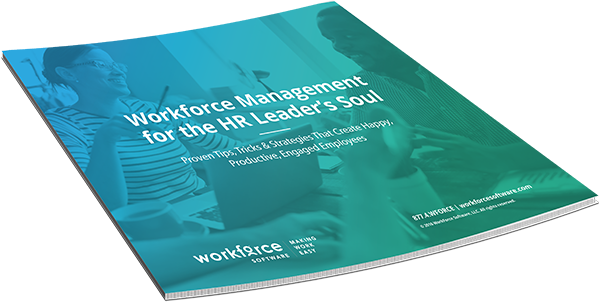An HR Researcher Explains the One Workplace Characteristic Shared by Every Great Company

In a moment, you’re going to learn all about the one characteristic that can either make or destroy a work environment.
You’re going to learn what it is, how it was discovered, and what great companies have done to embrace and proliferate it. With some practice, you’ll also learn how to harness the energy this characteristic emits—a valuable skill that will stay with you for the rest of your life.
A skill that will help you read employees and, over time, connect with them.
Don’t worry, the pieces will all come together soon.
But first, a story. Let me take you back to the beginning…
Subscribe to The WorkForce Blog
Learn the art and science of maintaining productive, happy, engaged employees.
Meet Robert Levering, HR Researcher.
He’s a real person who, for a long time, worked as a labor journalist.
Robert’s job was to report on strikes, union organizing drives, employee lawsuits, and other events that were the product of toxic workplaces. Then, one day, out of the blue, a New York publisher came to him with a request:
“I want you to write a book called The 100 Best Companies to Work for in America,” she said. And while it was an exciting ask, the topic was hardly in his wheelhouse. Robert wrote about bad experiences at bad companies, not the other way around.
He took the job anyway.
Over the next two years, Levering traveled around the U.S. interviewing more than 3000 employees from 150 companies. Except this time he wasn’t asking them what they hated about work but, rather, what made them love it? What made them happy, eager, and successful employees at their company?
The book he was asked to write became a bestseller, but he didn’t stop there. He dug deeper, continuing his research into workplace happiness and satisfaction. Levering went on to spend another two years revisiting the top 20 workplaces on his list…
His goal: to find the one distinctive feature — the common denominator — that made them all great. After a combined four years of research, he published his findings in a follow-up book, A Great Place to work: What Makes Some Employers So Good—and Most So Bad.
What he learned surprised him:
Perks, it turns out, do not make a company a great place to work. Something else does, something far less tangible. Sure, free lunches and on-site daycare are remarkable workplace luxuries, but they’ll never make a company truly special.
“What really impressed me,” recalls Levering, “was the spirit within these companies. You could feel that spirit when you first walked in the door.” He attributed this spirit, this feeling, to the way employees and their respective managers interacted with each other. He clung to this observation, diving deeper into its basis, searching for a root cause.
Ultimately, he deduced that the most distinctive feature shared by the very best companies—the ones that retained the most talented and productive employees—was… you’ve heard of it: trust.
Trust is the foundation upon which healthy human relationships—whether they exist at the office or in the living room—form and evolve. And that fact begs the question:
 Workforce Management for the HR Leader’s Soul
Workforce Management for the HR Leader’s Soul
This book will help you create a healthy, rewarding environment for the people that keep your company moving forward.
How can companies create trust?
Conceptually speaking, creating trust is actually fairly simple…
According to Levering, it boils down to making an employee feel less like an instrument and more like a person. Managers, executives, and HR departments can do that by giving people more than they’ve been promised—and I’m not talking about money.
Let me explain.
Take Starbucks, for example:
Firstly, the world’s largest coffee chain doesn’t refer to their workers as “employees”—they’re called “partners.” Secondly, a partner’s first day on the job isn’t consumed with paperwork and accelerated coffee-making training, as one might expect.
Instead, new hires are guided through what’s known as the “Starbucks Experience,” in which the first activity is a relaxed, casual coffee-tasting tour. Nothing intense. Just coffee. It’s actually a nice way to spend the morning—and that’s the point.
Sure, part of the purpose behind the Starbucks Experience is to boost employees’ coffee knowledge. But it’s mainly designed to encourage bonding and, ultimately, welcome outsiders into the company family. Is Starbucks obligated to treat fresh faces this way? No, they’re not. New hires, after all, have entered into a contract with the company: we give you money, you give us time. That’s the deal.
But Starbucks understood that by providing people with something extra—by doing more than they have to do—especially on the first day, they’re far more likely to create a seed of trust that, if properly nurtured, could grow into an oak of loyalty.
According to Levering, Starbucks, in this instance, is practicing “Gift-Work.”
What is Gift-Work?
After three decades of research, Levering coined the term, which he defines as:
“An interaction in the workplace where an employee or a manager gives more than is expected or required for the sake of the organization or the relationship.”
HR translation: the less commoditized an employee feels, the more he or she will trust their manager and the organization as a whole. More trust creates more personal happiness, which drives on-the-job effort, which promotes positivity, energy.
Energy that, in the hands of a skilled manager, can be molded into productivity, innovation, and growth.
How is your company working to build trust?
Let us know in the comments below and earn a valuable backlink to your site!
Boost Employee Satisfaction
Give your employees (and yourself) the gift of
WorkForce Management Software

 Workforce Management for the HR Leader’s Soul
Workforce Management for the HR Leader’s Soul